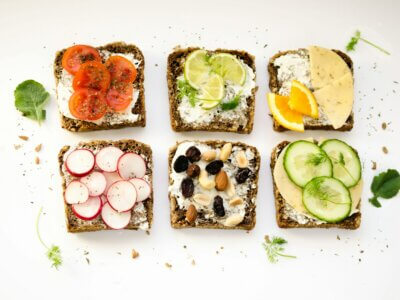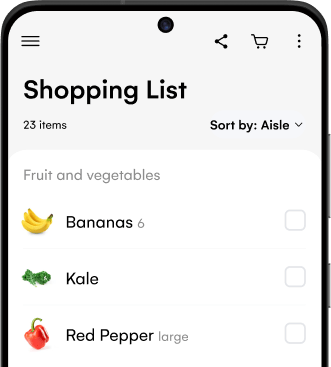Low carb diets have been in the spotlight for many decades but under different names. Does the Atkins diet ring a bell? Or keto? But are low carb diets actually helpful for weight loss or are they a hoax? Let’s break it down and see!
Analyse nutritional information for any recipe

What is a carb?
A carbohydrate, commonly known as a carb, is a macronutrient that provides the body with energy (calories). A low carb diet is when the amount of carbs are reduced and in turn, the fat and protein ratio increases. Carbs can be found in fruits, vegetables, beans, grains, and dairy products. Meanwhile, meat and fat have little to no carbs.
How many carbs does a low carb diet have?
A regular diet without any restrictions on carbohydrates can contain anything from 45-65% total calories from carbs. Low carb diets, on the other hand, can range anywhere from 20-40% of total calories. There are also very low carb diets, such as the keto diet, which is around 10% of calories (20-50 grams of carbs per day) and a no carb diet, which completely eliminates carbs.

Do low carb diets work for weight loss?
So now you know that there are low, very low, and no-carb diets. Carbs have long been the first food group people rule out. But if you’re looking to lose weight and improve your body composition, is it actually an effective weight management strategy?
While limiting carbs can help you to shed some extra pounds, it’s worth keeping in mind that they serve a useful purpose in our bodies and carbs don’t need to be demonized. However, reducing your carb intake and adding in extra leafy greens and lean protein could be beneficial.
The benefits of limiting carbohydrates
Low carb diets have been shown to be successful for weight loss. If your goal is to lose weight, a low carb diet may help. Weight loss may occur due to decreased caloric consumption by eliminating highly processed foods and refined carbs (bread, cookies, and cake) and replacing them with nutrient dense options.
Studies have shown that low carb diets can be an effective option for short term weight loss but there’s not much research on its long term results. Lower carb diets have been used for blood sugar control, which may be beneficial for those with diabetes. In addition to diabetes, eating a low carb diet may also be beneficial for obesity and hypertension. A diet that consists of mostly refined carbs and not enough protein, fiber, and fat, may lead to hunger and increased intake due to the increase in the release of insulin. Lowering the amount of carbs and eating enough protein, fat, and fiber may help reduce the release of insulin and increase satiety.
Switching to a low carb diet can be overwhelming at first. It’s best to start off slowly and make gradual changes rather than cutting out all carbs cold turkey. And remember, low carb diets don’t mean no carbs at all.
Creating balanced meals is a great way to ensure satiety so you don’t struggle so much with cravings. The right balance of protein, fat, and carbs is key to staying full and can vary from person to person. A loose rule of thumb is to have half of your plate consist of non-starchy veggies, a quarter of your plate consist of lean protein, then use the remaining quarter of your plate for your carbs.

The drawbacks of limiting carbohydrates
While weight loss is a huge benefit for some people, there also may be some adverse effects of a low carb diet such as constipation because it can be low in fiber. If you exercise a lot, you may also find that limiting carbohydrates has a negative impact on your performance. Depending on the type of exercise you do, the amount of recommended carbs differ and limiting carbohydrates may have a negative impact on your performance.
While low carb may help with blood sugar control, the research remains inconclusive on the long term impact of cholesterol, blood pressure, and other cardiovascular risk factors. Despite the drawbacks, carefully planning meals to include enough fiber and having an adequate amount of carbs may prevent these adverse effects.
There’s also the argument that weight loss occurs not because of the effect of carbs on your body but simply because limiting access to carbs may also reduce your overall calorie intake – as well as your consumption of high-calorie and low satiety foods like potato chips and refined white bread.
This is a good thing, of course! But because weight loss occurs from creating a calorie deficit, you may have the same results while including carbohydrates and simply understanding your caloric needs and limiting processed or ‘junk’ food. Another thing to remember is that if you cut carbs but simply replace them with fat or protein, you’ll still be consuming the same amount of calories overall and won’t lose weight.
If you are following a low carb diet and feel like you are not meeting your weight loss goals, keeping track of your meals may be helpful. It is important to speak with your healthcare provider prior to making any changes to your current diet.
Low carb diet plans
There are many variations of a low carb diet. The amount of carbs can range from 0-150 grams of carbs per day depending on the person, their eating habits, and their goals. Some of the well-known variations include:
- Low Carb Diet: Approximately 100-150 grams of carbs per day or 20-40% of calories from carbs.
- The Atkins diet: This diet gained popularity in the 90’s. The focus was on different phases, ranging from less than 20 grams of carbs per day to no more than 50 grams of carbs per day.
- Low glycemic: this diet focuses on the impact the food has on blood sugar. The type of carbs in the diet is considered rather than just the overall amount of carbs. You can find the glycemic index and glycemic load under the health score when you view a recipe on Samsung Food.
- Ketogenic (keto) diet: The keto diet is more restrictive than a standard low carb diet.The purpose of the keto diet is to put your body in ketosis, so it uses fat as its main energy source instead of carbs. The Keto diet restricts carbs to 20-50 grams of carbs per day. For someone on a 2000 calorie diet, this is about 10% carbs – equivalent to a small apple.
- No carb diet: This tends to be a little more restrictive than keto by not allowing any types of carbs. Essentially, you are limited to protein and fat.

Low carb diet foods
When you think of low carb foods, do bacon, eggs, and cheese come to mind? While these do feature on many low carb diets, there are loads of options available. You can easily include a wide variety of foods with plenty of vegetables and protein.
Plan ahead and say goodbye to meal time madness

The USDA Nutrient Database is a valuable resource when trying to figure out how many carbs are in certain foods. Samsung Food app has a countless amount of recipes, communities, and resources to help make meal planning for specific dietary needs easier. Samsung Food app also calculates the amount of carbs for any given recipe. Let’s take a look at some foods that can be consumed on a low carb diet:
- Non-starchy vegetables include fiber and contain around 5-10 grams of carbs per serving. These include but are not limited to: broccoli, carrots, mushrooms, bell peppers, spinach, lettuce, and cauliflower. You can usually eat as much of these as you want on a low carb diet.
- Fruits include fiber and have more carbs than vegetables. The amount of carbs vary based on the type of fruit and serving size. Many low carb diets include fruits like watermelon, berries, cantaloupe, avocado, and peaches.
- Starches and starchy vegetables are the most carb rich type of food. These don’t need to be completely eliminated for a low carb diet. The serving size simply needs to be adjusted to fit within your daily carb intake. Some foods which fall in this category include corn, baked potato, quinoa, brown rice, butternut, beetroot, whole oats, and peas. When possible, it’s best to opt for wholegrain options.
- Protein has little to no carbs. These include but are not limited to: chicken, beef, shrimp, tofu, eggs, crab, and turkey.
- Fat has zero carbs. Healthier fat options include certain nuts, seeds, and olive oils.
How can you manage your progress?
Working with a registered dietitian can help ensure all nutrients are met and enough fiber is consumed. Losing interest in food choices is one of the biggest reasons a low carb diet is hard to stick to.
Meal planning is a great way to stay on track when it comes to adhering to new diets. Samsung Food has thousands of low carb recipes with macronutrient breakdown glycemic load, so you don’t have to stick to the same boring meal each night.
Knowing you have options could be the difference between sticking to your meal plan or ordering takeout. So, why not download Samsung Food and add some low-carb recipes to your planner today?



